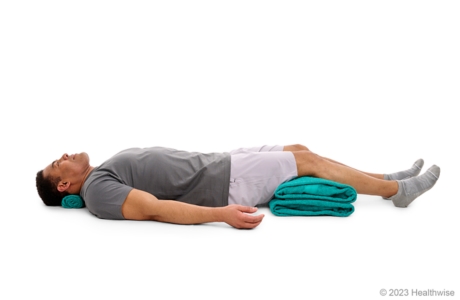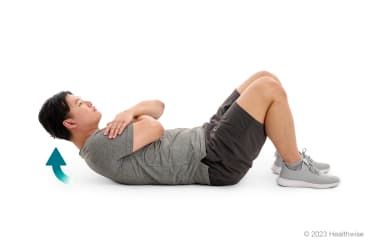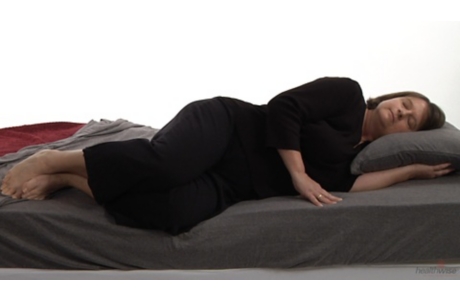Low Back Pain: Exercises to Reduce Pain
Overview
Most people who have back pain naturally feel better by doing certain motions. Some feel better when they sit. Others feel better when they stand. Exercise that moves you toward your more comfortable position usually works better to treat your back pain.footnote 1 For example, if you are more comfortable sitting down, exercises that bend you forward—such as partial sit-ups (curl-ups) and knee-to-chest exercises—may help.
The exercise programs that work best for chronic low back pain are designed specifically for you and are supervised.footnote 2 For example, a physical therapist might teach you an exercise program that you can use at home. Then you would see the therapist every so often to check on your progress and advance your program.
- Talk to your doctor or physical therapist if you aren't sure how to do the exercises or if you feel any pain when you do them.
- Try to exercise a little bit every day.
- Get some type of aerobic exercise, such as walking, every day. Even a couple of minutes will be helpful, and you can slowly increase your time.
- Choose a couple of stretching and strengthening exercises that you enjoy doing, or vary them from day to day.
How do you exercise to reduce low back pain?
If pain is eased by standing or lying down
Alternate arm and leg (bird dog)

- Start on the floor, on your hands and knees.
- Tighten your belly muscles by pulling your belly button in toward your spine. Be sure you continue to breathe normally and do not hold your breath.
- Keeping your back and neck straight, raise one arm off the floor and hold it straight out in front of you. Be careful not to let your shoulder drop down, because that will twist your trunk.
- Hold for about 6 seconds, then lower your arm and switch to your other arm. Over time, work up to holding for 10 to 30 seconds each time.
- Repeat 8 to 12 times with each arm.
When you feel steady and strong doing this exercise with your arms, try doing the exercise with your legs instead. Raise one leg and hold it straight out behind you. Be careful not to let your hip drop down, because that will twist your trunk.
When holding your leg straight out becomes easier, try raising your opposite arm at the same time.
Backward bend

- Stand with your feet hip-width apart. Your toes should point forward. Do not lock your knees.
- Place your hands in the small of your back.
- Bend backward as far as you can, keeping your knees straight. Hold this position for a few seconds. Then return to your starting position.
- Repeat 2 to 4 times. Each time, try to bend backward a little farther, until you bend backward as far as you can.
Bridging (feet flat)

- Lie on your back with both knees bent and your feet flat on the floor. Your knees should be bent about 90 degrees.
- Tighten your belly muscles by pulling your belly button in toward your spine. Keep breathing normally and don't hold your breath.
- Push your feet into the floor, squeeze your buttocks, and lift your hips off the floor until your shoulders, hips, and knees are all in a straight line. Keep your hips level.
- Hold for about 6 seconds.
- Slowly lower your hips back to the floor.
- Repeat 8 to 12 times.
Hip flexor stretch (kneeling)

- Kneel on your affected leg and bend your other leg out in front of you, with that foot flat on the floor. If you feel discomfort in the front of your knee, place a towel under your knee.
- Keeping your back straight, slowly push your hips forward. You should feel a stretch in the upper thigh of your back leg and hip.
- Hold the stretch for at least 15 to 30 seconds.
- Repeat 2 to 4 times.
- It's a good idea to repeat these steps with your other leg.
Press-up back extension

- Lie on your stomach, supporting your body with your forearms. Keep your elbows below your shoulders.
- Press your elbows down into the floor to raise your upper back. As you do this, relax your stomach muscles and allow your back to arch without using your back muscles. Don't let your hips or pelvis come off the floor.
- Hold for 15 to 30 seconds, then relax.
- Repeat 2 to 4 times.
Supported rest

- Lie on your back with a rolled towel under your neck. Support your knees with something, such as pillows or folded towels or blankets. Extend your arms comfortably to your sides.
- Relax and breathe normally.
- Remain in this position for about 10 minutes.
- If you can, do this 2 or 3 times each day.
If pain is eased by sitting
Double knee-to-chest stretch

- Lie on your back with your knees bent and your feet flat on the floor. You can put a small pillow under your head and neck if it is more comfortable.
- Bring your knees to your chest and hold them with your hands. Or you can hold at the fronts of your shins or behind your thighs.
- Keep your lower back pressed to the floor. Hold the stretch for 15 to 30 seconds.
- Relax, and lower your knees to the starting position.
- Repeat 2 to 4 times.
Piriformis stretch (from legs bent)

- Lie on your back with your knees bent.
- Lift your affected leg and rest that ankle on your other knee.
- Use your hands to gently pull your knee toward your opposite shoulder. You should feel a stretch in your buttock and hip.
- Hold for 15 to 30 seconds.
- Repeat 2 to 4 times.
- It's a good idea to repeat these steps with your other leg.
Single knee-to-chest stretch

- Lie on your back with your knees bent and your feet flat on the floor. You can put a small pillow under your head and neck if it is more comfortable.
- Clasp your hands under one knee and bring the knee to your chest. Keep your other foot flat on the floor.
- Keep your lower back pressed to the floor. Hold the stretch for at least 15 to 30 seconds.
- Relax and lower the knee to the starting position.
- Repeat 2 to 4 times with each leg.
To get more stretch, put your other leg flat on the floor while pulling your knee to your chest.
If no position relieves pain
Back press

- Stand with your back 10 to 12 inches away from a wall.
- Lean into the wall until your back is against it. Press your lower back against the wall by pulling in your stomach muscles.
- Slowly slide down until your knees are slightly bent, pressing your lower back into the wall.
- Hold for at least 6 seconds, then slide back up the wall.
- Repeat 8 to 12 times.
Over time, work up to holding this position for as much as 1 minute.
Cat-cow

- Get on your hands and knees. Your shoulders should be directly above your wrists, and your hips should be above your knees. Your back should be flat, and your neck should extend straight out from your spine. Your gaze should be toward the floor below.
- Relax your head and allow it to droop. Round your back up toward the ceiling until you feel a nice stretch in your upper, middle, and lower back. Hold this stretch for as long as it feels comfortable, or about 15 to 30 seconds.
- Then let your back curve down by pressing your stomach toward the floor. Lift your buttocks toward the ceiling. If it doesn't bother your neck, you can raise your head as you allow your back to sway. Hold this position for 15 to 30 seconds.
- Go back and forth smoothly 2 to 4 times between the rounded back and swayed back positions.
If you have a neck problem or injury, keep your neck in the original position in line with your torso instead of moving it with your spine.
Clamshell for back problems

- Lie on your side with a pillow under your head. Keep your feet and knees together and your knees bent.
- Raise your top knee, but keep your feet together. Do not let your hips roll back. Your legs should open up like a clamshell.
- Hold for about 6 seconds.
- Slowly lower your knee back down.
- Repeat 8 to 12 times.
- Switch to your other side and repeat the steps.
Curl-up (arms crossed)

- Lie on your back on the floor, with your knees bent and your feet flat on the floor. (Or you can lie on any flat surface, such as a bed.)
- Cross your arms over your chest. If this bothers your neck, try putting your hands behind your neck (not your head), with your elbows spread apart.
- Slowly tighten your belly muscles and raise your head and shoulder blades off the floor. Keep breathing normally and don't hold your breath.
- Keep your neck straight and do not press your chin to your chest.
- Hold for 1 to 2 seconds. Then slowly lower yourself back to the floor.
- Repeat 8 to 12 times.
Front plank (beginner)

- Lie on your stomach, supporting your body with your forearms. Keep your elbows under your shoulders.
- Press down on your forearms and lift your hips off the floor so that you are supporting your body on your elbows and knees.
- Keep your body straight by tightening your belly and buttocks muscles.
- Hold for about 6 seconds. Over time, build up to about 30 seconds.
- Rest for up to 10 seconds.
- Repeat 3 to 5 times.
Hamstring stretch in a doorway

- Sit on the floor close to a doorway. Be sure to stretch your affected leg first.
- Lie down with your other leg through the doorway.
- Slide your affected leg up the wall to straighten your knee. Don't point your toes. You should feel a gentle stretch down the back of your leg. Be sure to:
- Hold the stretch for at least 1 minute. Then over time, try to lengthen the time you hold the stretch to as long as 6 minutes.
- Repeat 2 to 4 times.
- It's a good idea to repeat these steps with your other leg.
- To stretch your right leg, scoot to the right side of the doorway.
- To stretch your left leg, scoot to the left side of the doorway.
- Keep both knees straight.
- Keep your back flat and your other heel on the floor.
If you do not have a place to do this exercise in a doorway, there is another way to do it:
- Lie on your back, and bend the knee of your affected leg.
- Loop a towel under the ball and toes of that foot, and hold the ends of the towel in your hands.
- Straighten your knee as you raise that foot into the air. Slowly pull back on the towel. You should feel a gentle stretch down the back of your leg.
- Hold the stretch for 15 to 30 seconds. Or even better, hold the stretch for 1 minute if you can.
- Repeat 2 to 4 times.
- It's a good idea to repeat these steps with your other leg.
Pelvic rocking (seated)

- Sit in a comfortable, neutral position, with your feet flat on the floor and your buttocks near the front of the seat.
- Gently roll your shoulders forward as you roll your hips and your lower spine back. Feel the weight move backward on your "sit" bones.
- Now straighten up slowly. Pull your shoulders back as your hips and lower spine rock forward, arching your back.
- Repeat 8 to 12 times, gently rocking your pelvis backward and forward.
Pelvic rock (standing)

- Stand in a comfortable, neutral position with your feet hip-width apart. Place your hands on your hips, with your fingers in front.
- Gently rock the top of your hips backward, flattening your back. Your fingers will move up slightly.
- Return to the neutral position.
- Now gently rock the top of your hips forward, arching your back. Your fingers will move down slightly.
- Return to the neutral position.
- Repeat 8 to 12 times, gently rocking your pelvis backward and forward.
Pelvic tilt

- Lie on your back with your knees bent and your feet flat on the floor.
- Tighten your belly muscles by pulling your belly button in toward your spine. Press your lower back to the floor. You should feel your hips and pelvis rock back.
- Hold for about 6 seconds while breathing smoothly, and then relax.
- Repeat 8 to 12 times.
Side plank (beginner)

- Lie on your side with your knees bent. Prop your upper body up on your elbow, with your elbow under your shoulder.
- Raise your hips off the floor.
- Keep your body straight by tightening your belly and buttocks muscles.
- Hold for about 6 seconds. Over time, build up to about 30 seconds.
- Repeat 3 to 5 times on each side.
Side plank (intermediate)

- Lie on your side with your legs straight. Prop your upper body up on your elbow, with your elbow under your shoulder.
- Keeping your legs straight, raise your hips off the floor.
- Keep your body straight by tightening your belly and buttocks muscles.
- Hold for about 6 seconds. Over time, build up to about 30 seconds.
- Repeat 3 to 5 times on each side.
Walking

- Practice good posture as you walk.
- Start out slowly. Choose an area that's level and clear of things that might make you trip.
- Over time, increase how far and how long you walk.
- Stand up straight. Leaning forward or backward as you walk can put strain on your back.
- Keep your head up and your eyes forward.
- Shrug your shoulders every once in a while and then relax them. This will remind you not to tense your shoulders as you walk.
If it hurts to walk or doesn't feel right, talk to your doctor.
Credits
Current as of: July 31, 2024
Author: Ignite Healthwise, LLC Staff
Clinical Review Board
All Healthwise education is reviewed by a team that includes physicians, nurses, advanced practitioners, registered dieticians, and other healthcare professionals.
Current as of: July 31, 2024
Author: Ignite Healthwise, LLC Staff
Clinical Review Board
All Healthwise education is reviewed by a team that includes physicians, nurses, advanced practitioners, registered dieticians, and other healthcare professionals.


